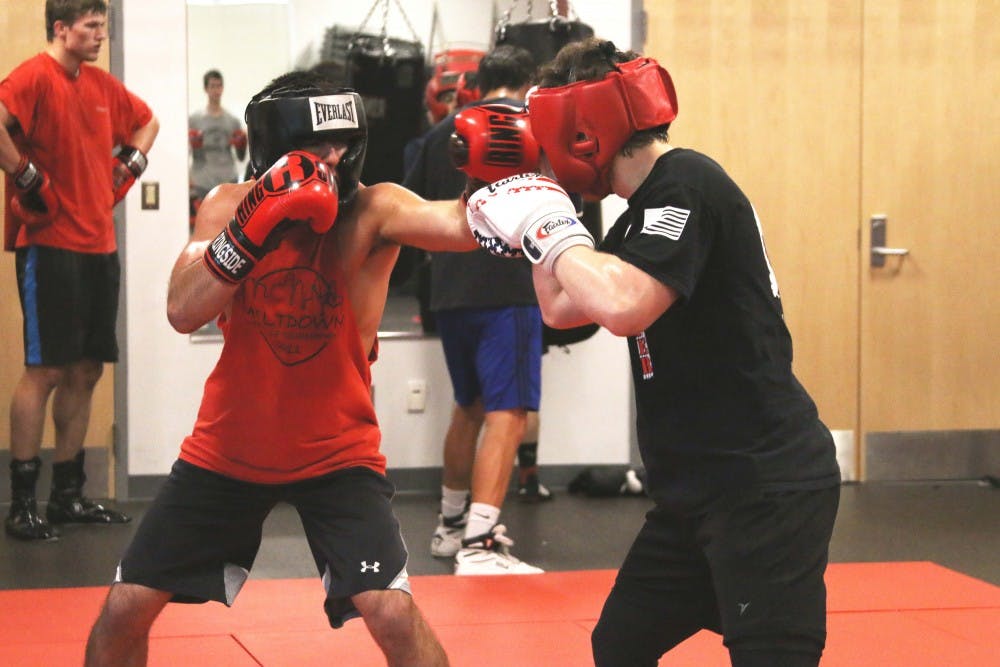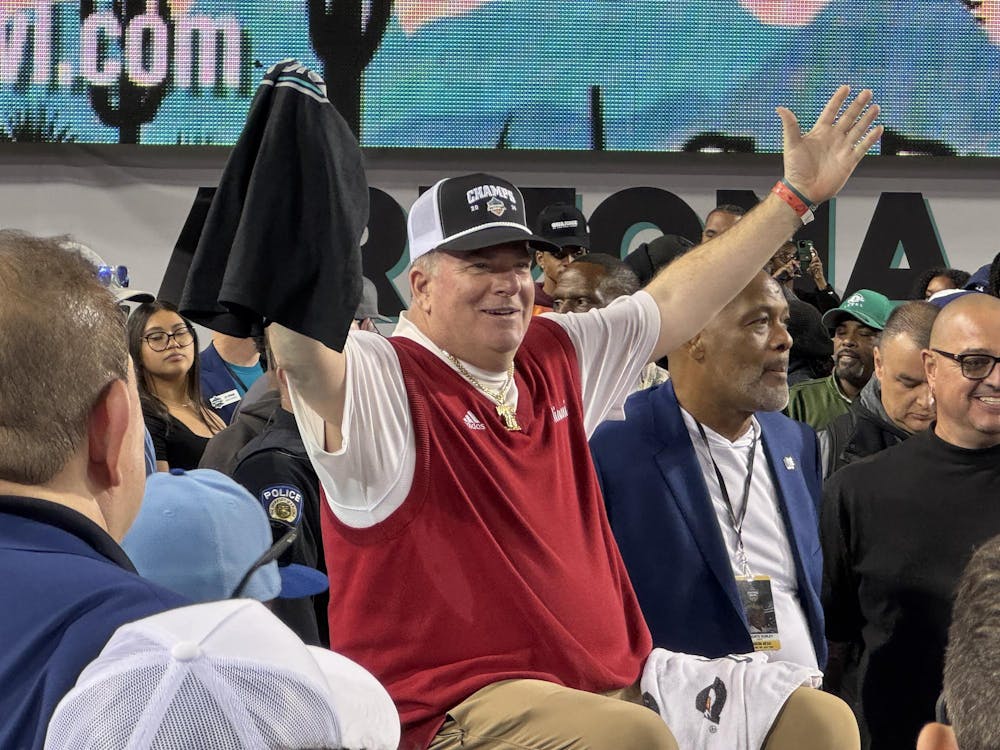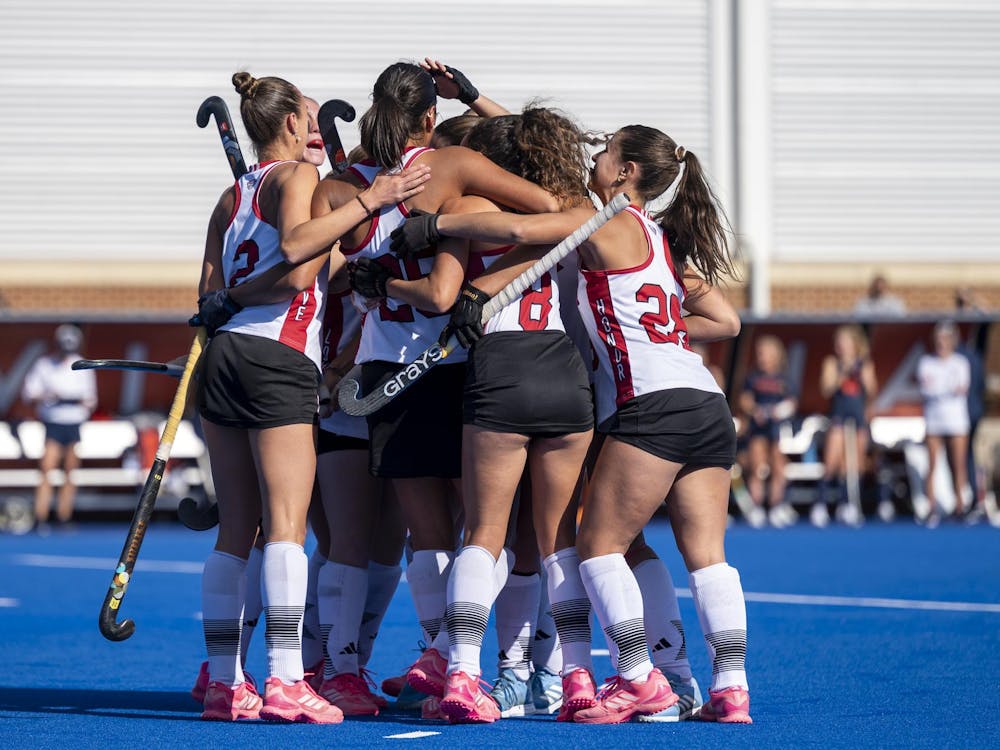Ten jump ropes whirred rhythmically on Thursday evening at Chestnut Field House. The pitter-patter of sneakers hitting the gym floor almost matched the drops of rain hitting the sidewalk outside, and not long after, the sweat of the Miami club boxers matched the humidity of the March evening in Oxford.
The only mismatch of the evening was the light-heartedness of the four recreational boxers and six competitive boxers participating in a sport that requires a certain mental toughness unlike any other sport.
"No one wants to get punched, but we come out and do it for fun every day," senior Parker Brown said.
Before someone could figure out how to work the aux-cord, you could hear one boxer poke fun at another's jump-roping ability. A recreational member welcomed a first-time visitor to the club's 4 to 6 p.m. practice block. The six competitive boxers called out to each other and asked about making weight for the upcoming national competition.
When the music came on, the boxers wrapped their hands and put on their gloves. Speed bags and heavy bags were punched. The room got louder as the boxers got quieter.
They all "shadow-boxed" against imaginary opponents -- practicing footwork and technique before coach Eric Buller arrived.
The recreational boxers, three girls and one guy, occasionally made eye contact and joked with each other while shadow boxing, whereas the competitive group of six guys stared into the eyes of imaginary opponents.
The boxers exhaled with each punch, making a noise similar to a musician imitating symbols clashing or a rapper beat-boxing, in order to ensure their core is tight when receiving a blow from their imaginary opponent.
No one talked about what to do next, but everyone moved seamlessly from one exercise to the next when the digital bell rang from the speakers.
Miami Club Boxing has worked this way for the past six and a half years, since Buller took over in 2011. The team has always been registered with the National Collegiate Boxing Association, part of USA Boxing, but it wasn't until five years ago when the team culture shifted and became more competitive.
There's still a recreational aspect, and up to 20 regulars attend practice every evening. The six competitive members are required to attend practice, a standard of excellence established several years ago.
"I like the culture we have in the club now," Buller said. "As a result, we compete better than we used to. Now, when people match up with a Miami boxer, they know it's not something easy. They know they're going up against a boxer who trains hard, is in shape and knows what they're doing."
Enjoy what you're reading?
Signup for our newsletter
These boxers do know what they're doing, as four of them are regional champions and one is a regional runner-up. The regional champions - Brown, junior Ryan Adelson, senior Adan Salguero and junior Harold Rogers -- will enter the National lottery to be seeded first, second or third in their respective weight class and sophomore Jacob Isele, the regional runner-up, will be seeded either fourth or fifth.
All five will box for individual belts, with their placings ultimately counting toward Miami's team score.
Placing in the top four makes a boxer an all-American. For the past couple years, Miami club boxing has placed in the top 10 as a team, usually behind service academies. This year, with an unprecedented five regional champions and three former all-Americans, the boxing team is optimistic heading to West Point, NY.
Furrowed eyebrows and sweat-soaked cotton t-shirts don't convey the expected optimism from the boxers. Even after months of practice, running six days a week, intense conditioning and a strict diet, the boxers' body language isn't over-confident.
To an untrained eye, any boxers' practice boxing, known as sparring, looks exactly like the others, but each of the five judges will rate a boxer's technique as superior or inferior to their opponent.
Though technique objectively determines a boxing National Champion, mental toughness, attitude, commitment, conditioning and a pinch of natural talent create the competitive athlete that is a Miami club boxer.
"Boxing is like no other sport," Adelson said. "You don't hear people say, 'do you play boxing?' It's a lifestyle. When I'm in boxing season, you live it. You can't half-ass it."
Halfway through his sparring, Isele takes a punch to the face, and his nose starts to bleed. Blood drips, dotting the already red mats. The lack of reaction from the boxers is unnerving.
The automated bell rings, and the boxers tap gloves as a high-five.
Isele gets paper towels to stop his nosebleed, while his teammates use Clorox wipes to clean up the blood. Buller makes a mental note of the momentary injury. As president of the NCBA, he logs all injuries for every match across the country throughout the season -- ensuring the safety and continuation of collegiate boxing.
A final spar, a final workout circuit by the rec team and a final technique practice on the heavy bags end before the last bell rings from the speakers. Each boxer unwraps their hands and softens their brows - smiles creep onto the faces of the now spent athletes.
"I have a love/hate relationship with [fighting] because it's so hard and pretty scary, but it feels really good to do," Rogers said. "Especially if you win."
The competitive boxers will travel to New York today, and compete from April 5 to the 7. And, they'll continue to love the sport where they have to hate their opponent for three two-minute rounds.
"There's nothing like it," Adelson said. "There's no other feeling than stepping into the ring and seeing an opponent across from you."




